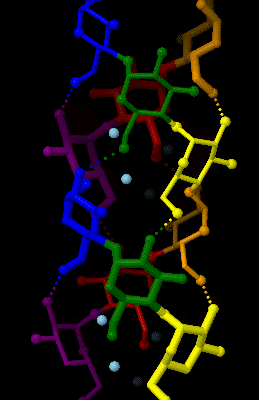Amylose
Amylose is a polysaccharide made up of glucose units linked by α(1→4) bonds. It is one of the two components of starch, the other being amylopectin. Unlike amylopectin, which is branched, amylose is typically a linear molecule, although it can have a few branches. Amylose is an important dietary fiber, contributing to the bulk of food, slowing down digestion, and impacting the glycemic index of foods.
Structure and Properties[edit | edit source]
Amylose molecules consist of long chains of glucose units connected by α(1→4) glycosidic bonds. The number of glucose units (degree of polymerization) in amylose can vary significantly, typically within the range of 300 to 3000 glucose units. This linear structure allows amylose to adopt a helical conformation, which is stabilized by hydrogen bonding within the helix. The helical structure of amylose can trap iodine molecules, leading to a characteristic blue-black color when iodine is added to a solution containing amylose, a property utilized in the iodine test for starch.
The solubility of amylose in water is relatively low compared to amylopectin, and it tends to form a gel when heated in water and then cooled. This gelation property is important in the food industry, influencing the texture and mouthfeel of various starchy foods.
Role in Plants[edit | edit source]
In plants, amylose is synthesized by the enzyme GBSS (granule-bound starch synthase), which elongates the glucose chain by adding glucose units from ADP-glucose. Amylose is primarily stored in plant starch granules within plastids, such as chloroplasts in leaves and amyloplasts in storage organs like seeds and tubers. The ratio of amylose to amylopectin varies among different plant species and even within different parts of the same plant, significantly affecting the plant's energy storage efficiency and the physicochemical properties of the starch.
Dietary and Nutritional Aspects[edit | edit source]
Amylose, being a form of dietary fiber, plays a crucial role in human nutrition. Foods high in amylose, such as certain varieties of rice, beans, and potatoes, have a lower glycemic index, meaning they cause a slower rise in blood glucose levels after consumption. This slow digestion and absorption can be beneficial for weight management and controlling conditions like diabetes.
Industrial and Biotechnological Applications[edit | edit source]
The unique properties of amylose, such as its ability to form films and gels, have led to its use in various industrial applications. In the food industry, amylose is used as a thickener, stabilizer, and emulsifier. It is also explored for use in biodegradable plastics and as a matrix for the controlled release of drugs in pharmaceutical formulations.
Research and Genetic Engineering[edit | edit source]
Research into amylose has focused on understanding its structure and biosynthesis to manipulate its levels in crops through genetic engineering. By altering the expression of genes involved in starch synthesis, scientists aim to produce crops with modified starch content for specific industrial and nutritional purposes. For example, increasing the amylose content in rice can produce rice with a lower glycemic index, beneficial for diabetic individuals.
This article is a biochemistry stub. You can help WikiMD by expanding it!
Search WikiMD
Ad.Tired of being Overweight? Try W8MD's physician weight loss program.
Semaglutide (Ozempic / Wegovy and Tirzepatide (Mounjaro / Zepbound) available.
Advertise on WikiMD
|
WikiMD's Wellness Encyclopedia |
| Let Food Be Thy Medicine Medicine Thy Food - Hippocrates |
Translate this page: - East Asian
中文,
日本,
한국어,
South Asian
हिन्दी,
தமிழ்,
తెలుగు,
Urdu,
ಕನ್ನಡ,
Southeast Asian
Indonesian,
Vietnamese,
Thai,
မြန်မာဘာသာ,
বাংলা
European
español,
Deutsch,
français,
Greek,
português do Brasil,
polski,
română,
русский,
Nederlands,
norsk,
svenska,
suomi,
Italian
Middle Eastern & African
عربى,
Turkish,
Persian,
Hebrew,
Afrikaans,
isiZulu,
Kiswahili,
Other
Bulgarian,
Hungarian,
Czech,
Swedish,
മലയാളം,
मराठी,
ਪੰਜਾਬੀ,
ગુજરાતી,
Portuguese,
Ukrainian
Medical Disclaimer: WikiMD is not a substitute for professional medical advice. The information on WikiMD is provided as an information resource only, may be incorrect, outdated or misleading, and is not to be used or relied on for any diagnostic or treatment purposes. Please consult your health care provider before making any healthcare decisions or for guidance about a specific medical condition. WikiMD expressly disclaims responsibility, and shall have no liability, for any damages, loss, injury, or liability whatsoever suffered as a result of your reliance on the information contained in this site. By visiting this site you agree to the foregoing terms and conditions, which may from time to time be changed or supplemented by WikiMD. If you do not agree to the foregoing terms and conditions, you should not enter or use this site. See full disclaimer.
Credits:Most images are courtesy of Wikimedia commons, and templates, categories Wikipedia, licensed under CC BY SA or similar.
Contributors: Prab R. Tumpati, MD


